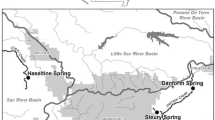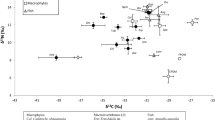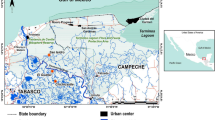Abstract
Stable isotope and fatty acid analyses were used to study carbon sources for animals in a submerged plant bed. Epiphytes growing on Potamogeton perfoliatus, sand microflora, and alder leaves were the most important carbon sources. The most abundant macrophyte, P. perfoliatus was unimportant as a food source. Modelling (IsoSource) showed that epiphytes were the most important food source for the most abundant benthic invertebrates, the isopod Asellus aquaticus (annual mean contribution 64%), the amphipod Gammarus pulex (66%), and the gastropod Potamopyrgus antipodarum (83%). The mean annual contributions of sand microflora were, respectively, 21, 19, and 9%; and of alder leaves, 15, 15, and 8% for these three species. The relative importance of carbon sources varied seasonally. The relative contribution of epiphytes was lowest for all three grazer species in July: A. aquaticus 38%, G. pulex 43%, and P. antipodarum 42%. A decline in epiphyte biomass in summer may have caused this switch to less attractive food sources. P. perfoliatus provided habitat and shelter for consumers, but food was mainly supplied indirectly by providing space for attached epiphytes, which are fast-growing and provide a highly nutritious food source.




Similar content being viewed by others
References
Aberle N, Hillebrand H, Grey J, Wiltshire KH (2005) Selectivity and competitive interaction between two benthic invertebrate grazers (Asellus aquaticus and Potamopyrgus antipodarum): an experimental study using 13C- and 15N-labelled diatoms. Freshw Biol 50:369–379
Arts MT, Wainman BC (1999) Lipids in freshwater ecosystems. Springer, New York
Brett MT, Müller-Navarra DC, Ballantyne AP, Ravet JL, Goldman CR (2006) Daphnia fatty acid composition reflects that of their diet. Limnol Oceanogr 51:2428–2437
Brönmark C (1994) Effects of tench and perch on interactions in a freshwater, benthic food chain. Ecology 75:1818–1828
Burkholder JM, Wetzel RG (1989) Epiphytic microalgae on natural substrata in a hard water lake: seasonal dynamics of community structure, biomass and ATP content. Arch Hydrobiol Suppl 83(Suppl):1–56
Cattaneo A, Kalff J (1980) The relative contribution of aquatic macrophytes and their epiphytes to the production of macrophyte beds. Limnol Oceanogr 25:280–289
Connolly RM, Hindell JS, Gorman D (2005) Seagrass and epiphytic algae support nutrition of a fisheries species, Sillago schomburgkii, in adjacent intertidal habitats. Mar Ecol Prog Ser 286:69–79
Desvilettes C, Bourdier G, Amblard C, Barth B (1997) Use of fatty acids for the assessment of zooplankton grazing on bacteria, protozoa and microalgae. Freshw Biol 38:629–637
Dorn NJ, Mittelbach GG (2004) Effects of a native crayfish (Orconectes virilis) on the reproductive success and nesting behaviour of sunfish (Lepomis spp.). Can J Fish Aquat Sci 61:2135–2143
Eggers T, Jones TH (2000) You are what you eat or are you? TREE 15:265–266
Feminella JW, Hawkins CP (1995) Interactions between stream herbivores and periphyton: a quantitative analysis of past experiments. J N Am Benthol Soc 14:465–509
France RL, Peters RH (1997) Ecosystem differences in the trophic enrichment of 13C in aquatic food webs. Can J Fish Aquat Sci 54:1255–1258
Frostegård A, Bååth E (1996) The use of phospholipid acid analysis to estimate bacterial and fungal biomass in soil. Biol Fertil Soils 22(1):59–65
Gohse-Reimann S (2007) Untersuchungen zur Ernährungsökologie benthischer invertebraten im Makrophytensystem: ein marin-limnischer ansatz. Christian-Albrechts-University, Kiel, p 213
Graça MAS, Maltby L, Calow P (1993) Importance of fungi in the diet of Gammarus pulex and Asellus aquaticus I: feeding strategies. Oecologia 93:139–144
Hadwen WL, Bunn SE (2005) Food web responses to low-level nutrient and 15N-tracer additions in the littoral zone of an oligotrophic dune lake. Limnol Oceanogr 50:1096–1105
Hargeby A, Blom H, Blindow I, Andersson G (2005) Increased growth recruitment of piscivorous perch, Perca fluviatilis, during a transient phase of expanding submerged vegetation in a shallow lake. Freshw Biol 50:2053–2062
Hecky RE, Hesslein RH (1995) Contributions of benthic algae to lake food webs as revealed by stable isotope analysis. J N Am Benthol Soc 14:631–653
Hughes AR, Jun Bando K, Rodriguez LF, Williams SL (2004) Relative effects of grazers and nutrients on seagrasses: a meta-analysis approach. Mar Ecol Prog Ser 282:87–99
Jacobsen D, Sand-Jensen K (2006) Herbivory of invertebrates on submerged macrophytes from Danish freshwaters. Freshw Biol 28(3):301–308
James MR, Hawes I, Weatherhead M (2000a) Removal of settled sediments and periphyton from macrophytes by grazing invertebrates in the littoral zone of a large oligotrophic lake. Freshw Biol 44:311–326
James MR, Hawes I, Weatherhead M, Stanger C, Gibbs M (2000b) Carbon flow in the littoral food web of an oligotrophic lake. Hydrobiol 441:93–106
Jaschinski S, Sommer U (2008) Functional diversity of mesograzers in an eelgrass-epiphyte system. Mar Biol 154:475–482
Jaschinski S, Hansen T, Sommer U (2008a) Effects of acidification in multiple stable isotope analyses. Limnol Oceanogr Methods 6:12–15
Jaschinski S, Brepohl D, Sommer U (2008b) Carbon sources and trophic structure in an eelgrass (Zostera marina L.) bed based on stable isotope and fatty acid analyses. Mar Ecol Prog Ser 358:103–114
Jeppesen E, Jensen JP, Sondergaard M, Lauridsen T, Pedersen LJ, Jensen L (1997) Top-down control in freshwater lakes: the role of nutrient state, submerged macrophytes and water depth. Hydrobiol 342(343):151–164
Jones JI, Waldron S (2003) Combined stable isotope and gut content analysis of food webs in plant-dominated, shallow lakes. Freshw Biol 48:1396–1407
Jones JI, Young JO, Eaton JW, Moss B (2002) The influence of nutrient loading, dissolved inorganic carbon and higher trophic levels on the interaction between submerged plants and periphyton. J Ecol 90:12–24
Kelly DW, Dick JTA, Montgomery WE (2002) The functional role of Gammarus (Crustacea, Amphipoda): shredders, predators, or both? Hydrobiol 485:199–203
Keough JR, Sierszen ME, Hagley CA (1996) Analysis of a Lake Superior food web with stable isotope techniques. Limnol Oceanogr 41:136–146
Kerans BL, Dybdahl MF, Gangloff MM, Jannot JE (2005) Potamopyrgus antipodarum: distribution, density, and effects on native macroinvertebrate assemblages in the greater yellowstone ecosystem. J N Am Benthol Soc 24:123–138
Lee RF, Nevenzel JC, Paffenhoefer GA (1971) Importance of wax esters and other lipids in the marine food chain: phytoplankton and copepods. Mar Biol 9:99–108
Lodge DM (1991) Herbivory on freshwater macrophytes. Aquat Bot 41:195–224
Lodge DM, Kershner WM, Aloi JE, Covich AP (1994) Effects of an omnivorous crayfish (Orconectes rusticus) on a fresh-water littoral food-web. Ecology 75:1265–1281
Lorenzen OJ (1967) Determination of chlorophyll and phaeopigments: spectrophotometric equations. Limnol Oceanogr 12:343–346
Marcus JH, Sutcliffe DW, Willoughby LG (1978) Feeding and growth of Asellus aquaticus (Isopoda) on food items from the littoral of Windermere, including green leaves of Elodea canadensis. Freshw Biol 8:505–519
Michel P, Overdorff T (1995) Feeding habits of fourteen European freshwater fish species. Cybium 19:5–46
Moncreiff CA, Sullivan MJ (2001) Trophic importance of epiphytic algae in subtropical seagrass beds: evidence from multiple stable isotope analyses. Mar Ecol Prog Ser 215:93–106
Moore JW (1975) The role of algae in the diet of Asellus aquaticus L. and Gammarus pulex L. J Anim Ecol 44:719–730
Neundorfer JV, Kemp WM (1993) Nitrogen versus phosphorus enrichment of brackish waters: response of the submerged plant Potamogeton perfoliatus and its associated algal community. Mar Ecol Prog Ser 94:71–82
Newman RM (1991) Herbivory and detrivory on freshwater macrophytes by invertebrates: a review. J N Am Benthol Soc 10(2):89–114
Nyström P, Brönmark C, Granéli W (1999) Influence of an exotic and a native crayfish species on a littoral benthic community. Oikos 85:545–553
Otto C, Svensson CS (1981) How do macrophytes growing in or close to water reduce their consumption by aquatic herbivores? Hydrobiol 78:107–112
Peckham SD, Chipman JW, Lillesand TM, Dodson SI (2006) Alternate stable states and the shape of the lake trophic distribution. Hydrobiol 571(1):401–407
Phillips DL, Gregg JW (2003) Source partitioning using stable isotopes: coping with too many sources. Oecologia 136:261–269
Porter KG (1977) The plant–animal interface in freshwater ecosystems. Am Sci 65:159–170
Rozentsvet OA, Saksonov SV, Dembitsky VM (2002) Hydrocarbons, fatty acids, and lipids of freshwater grasses of the Potamogetonaceae family. Biochemistry 67:351–356
Solomon CT, Carpenter SR, Cole JJ, Pace ML (2008) Support of benthic invertebrates by detrital resources and current autochthonous primary production: results from a whole-lake 13C addition. Freshw Biol 53:42–54
Sullivan MJ, Moncreiff CA (1990) Edaphic algae are an important component of salt marsh food-web: evidence from multiple stable isotope analyses. Mar Ecol Prog Ser 62:149–159
Teal JM (1962) Energy flow in the salt marsh ecosystem in Georgia. Ecology 43:614–624
Underwood GJC, Thomas JD (1990) Grazing interactions between pulmonate snails and epiphytic algae and bacteria. Freshw Biol 23:505–522
Vadeboncoeur Y, Vander Zanden MJ, Lodge DM (2002) Putting the lake back together: reintegrating benthic pathways into lake food web models. Bioscience 52:44–54
Vadeboncoeur Y, Peterson G, Vander Zanden JM, Kalff J (2008) Benthic algae production across lake size gradients: interactions among morphometry, nutrients, and light. Ecology 89(9):2542–2552
Viso A-C, Marty J-C (1993) Fatty acids from 28 marine microalgae. Phytochemistry 34:1521–1533
Von Elert E (2002) Determination of limiting polyunsaturated fatty acids in Daphnia galeata using a new method to enrich food algae with single fatty acids. Limnol Oceanogr 47:1764–1773
Wiltshire KH, Boersma M, Möller A, Buhtz H (2000) Extraction of pigments and fatty acids from the green alga Scenedesmus obliquus (Chlorophyceae). Aquat Ecol 34:119–126
Wurzbacher CM, Bärlocher F, Grossart H-P (2010) Fungi in lake ecosystems. Aquat Microb Ecol 59:125–149
Acknowledgments
We thank T. Hansen for the analysis of the stable isotope samples. We also thank N. Aberle-Malzahn for helpful comments on the manuscript. S. Flöder provided valuable assistance in the field. The Brazilian National Counsel of Technological and Scientific Development (CNPq) and the German Research Foundation supported this work (So 145/20).
Author information
Authors and Affiliations
Corresponding author
Rights and permissions
About this article
Cite this article
Jaschinski, S., Brepohl, D.C. & Sommer, U. The trophic importance of epiphytic algae in a freshwater macrophyte system (Potamogeton perfoliatus L.): stable isotope and fatty acid analyses. Aquat Sci 73, 91–101 (2011). https://doi.org/10.1007/s00027-010-0163-6
Received:
Accepted:
Published:
Issue Date:
DOI: https://doi.org/10.1007/s00027-010-0163-6




